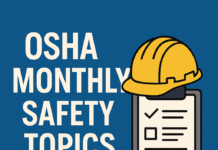
A Comprehensive Guide to OSHA Standards
Introduction
A Comprehensive Guide to OSHA Standards : Occupational Safety and Health Administration, commonly known as OSHA, plays a pivotal role in ensuring workplace safety and health in the United States. Understanding OSHA standards is crucial for both employers and employees to create a safe working environment. In this comprehensive guide, we will delve into the world of OSHA standards, exploring their significance, key standards, and how they impact workplaces across various industries.
What is OSHA?
OSHA, or the Occupational Safety and Health Administration, is a federal agency under the United States Department of Labor. Its primary mission is to ensure safe and healthy working conditions for employees in the United States by enforcing standards and regulations.
The Importance of OSHA Standards
Maintaining a safe workplace is not only ethically responsible but also legally mandated. OSHA standards serve several essential purposes:
1. Protecting Workers
OSHA standards protect workers from hazards that could lead to injuries, illnesses, or even fatalities. These standards cover a wide range of industries, from construction to healthcare, ensuring that employees are safe while on the job.
2. Reducing Costs
Implementing OSHA standards can lead to a reduction in workplace accidents and illnesses. This, in turn, lowers workers’ compensation costs and medical expenses for employers.
3. Boosting Productivity
A safe workplace leads to increased employee morale and productivity. Workers who feel secure in their environment are more likely to focus on their tasks and perform effectively.
Key OSHA Standards
To ensure workplace safety, OSHA has established numerous standards and regulations. Here are some of the key standards that apply to various industries:
1. General Industry Standards
- Hazard Communication (HCS): Ensures that information about chemical hazards is transmitted to workers through a comprehensive program.
- Fall Protection: Addresses fall hazards in various work settings, including walking and working surfaces.
2. Construction Standards
- Scaffolding: Regulations for the construction, use, and dismantling of scaffolds to protect workers from falls.
- Electrical: Guidelines for electrical systems in construction settings to prevent electrical accidents.
3. Healthcare Standards
- Bloodborne Pathogens: Ensures that healthcare workers are protected from exposure to bloodborne pathogens like HIV and hepatitis.
- Respiratory Protection: Addresses respiratory hazards in healthcare facilities, providing guidelines for proper equipment use.
4. Manufacturing Standards
- Lockout/Tagout (LOTO): Ensures the safety of employees working with machinery and equipment by controlling hazardous energy.
- Machine Guarding: Guidelines to protect workers from moving machinery parts.
Compliance with OSHA Standards
Ensuring compliance with OSHA standards is essential for both employers and employees. Employers are responsible for providing a safe workplace, which includes training employees on OSHA standards and regulations. Employees, on the other hand, should be aware of their rights and responsibilities regarding workplace safety.
Conclusion
In conclusion, OSHA standards are a cornerstone of workplace safety in the United States. They protect workers, reduce costs, and enhance productivity across various industries. Understanding and implementing OSHA standards is not only a legal requirement but also a moral obligation for employers. By adhering to these standards, we can create safer and healthier work environments for everyone.
OSHA Requirements for Employers
Occupational Safety and Health Regulations in the USA
Which is Better: NEBOSH, IOSH, or OSHA?
OSHA 30-Hour Construction Certification
OSHA 10-Hour Construction Certification
FAQs
- What is OSHA’s primary mission? OSHA’s primary mission is to ensure safe and healthy working conditions for employees in the United States by enforcing standards and regulations.
- How do OSHA standards benefit employers? OSHA standards benefit employers by reducing workplace accidents and illnesses, leading to lower costs and increased productivity.
- What are some key OSHA standards for the healthcare industry? Key OSHA standards for the healthcare industry include Bloodborne Pathogens and Respiratory Protection.
- Why is compliance with OSHA standards important? Compliance with OSHA standards is crucial to protect the safety and health of employees and to avoid legal repercussions for employers.
























